Osada Steve (長田スティーブ), just how long have you been in Japan now? I’m counting 25, 26 years.
I arrived in Japan in the late 1970s.
Be honest! Did you come here originally for the martial arts or Japanese bondage?
 Actually, neither. I had been bumming around in Asia for several years, and was looking for ways to replenish my funds. I arrived in Japan with a hundred dollars to my name, then spent my first week in some sort of flop house for day laborers at 800 yen a night. I quickly discovered that the Japan-is-Eldorado-for-cash-strapped-foreigners myth only applied to native English speakers. So for quite some time I subsisted on about $300/month that I earned from being an extra in movies and other odd jobs.
Actually, neither. I had been bumming around in Asia for several years, and was looking for ways to replenish my funds. I arrived in Japan with a hundred dollars to my name, then spent my first week in some sort of flop house for day laborers at 800 yen a night. I quickly discovered that the Japan-is-Eldorado-for-cash-strapped-foreigners myth only applied to native English speakers. So for quite some time I subsisted on about $300/month that I earned from being an extra in movies and other odd jobs.
In those days you could cover a decent distance by train for just 80 yen. Yet, I found myself walking a lot. I also had an empty stomach most of the time.
What is your martial arts background, ranks?
At the sprightly age of 16, I was approached by one of my schoolmates with a proposition to either join some Cuban-style underwater-guerilla fighting school or a taekwondo dojo. I settled for the latter.
Later I became a taekwondo uchi-deshi (live-in student) in Bangkok, where I first arrived in 1973 with the Vietnam War still under way. As part of my internship I found myself instructing the Thai Air Force in the silent art of kill-or-be-killed.
When I came to Japan I switched to karate where I trained at the Shotokan World Headquarters, then settled for Aikido at the Ueshiba Hombu Dojo.
You could say that for the first ten years, especially during my travels in Asia, I trained wherever I could find a dojo. For example, in the Philippines I trained at the YMCA, and in Korea, where I visited about 30 times, I picked up some hapkido.
While in Thailand, and later in Japan, I trained several hours a day.
Ranks? I recently bumped into one of my junior instructors who was uchi-deshi when I started aikido, and who is now a senior instructor at the Hombu Dojo. I asked him what rank he was, and he would politely avoid the question. I guess ranks are for students.
In any case, I haven’t trained for years, as my current activities as rope worker are incompatible with the warrior lifestyle. So from the practical point of view you could say my rank is below zero.
What can you tell us about your real activities in S.E. Asia? Rumor has it you have in your possession a get-out-of-jail-free card which carries more weight than a passport.
Hahaha. Yes, I still do keep one of those, but they were only good in Vietnam. Theoretically it would get you out of any tight spot but only if you were lucky. War is a dirty business.
Maybe I’m wrong, but it seems that you got into Shibari (縛り) quite awhile after first coming to Japan. Why the delay?
I have been tying all my life, but more or less in a private capacity, like everybody else. In terms of the Japanese style, until the late 1990s, I was merely a consumer of Japanese rope videos and mags. That all changed after I met my sensei, Osada Eikichi.
How did you first find out about Osada sensei? How was your Japanese language ability in those days?
I first met Osada Eikichi (長田英吉) at a photo shoot for Tokyo Journal magazine. That was like almost ten years ago. At that time my Japanese wasn’t too sharp. But lately I have made greater efforts to master the language. I am taking private lessons once a week now.
How did Osada sensei react to you when you first met him?
That first time I was taking photos of his weekly live show at the Bondage Bar (since closed) in Shinjuku. I don’t think he noticed me at all. Then, several months later, his  manager contacted me, and I arranged for him weekly shows at the Mistress Bar in Roppongi. Even later, I visited him there to take more photos and to see how he was doing. Naturally I was kind of helping with preparations and cleaning up, and he then asked me to assist him regularly. So the following week I started operating the pulley that he used in his show. Again several months later Osada Eikichi moved his shows to my own place, which we were then running together, and which is now known as Studio SIX.
manager contacted me, and I arranged for him weekly shows at the Mistress Bar in Roppongi. Even later, I visited him there to take more photos and to see how he was doing. Naturally I was kind of helping with preparations and cleaning up, and he then asked me to assist him regularly. So the following week I started operating the pulley that he used in his show. Again several months later Osada Eikichi moved his shows to my own place, which we were then running together, and which is now known as Studio SIX.
It was during that time that we became close. So it wasn’t a love-at-first-sight kind of thing, but more a gradual process that turned our relationship into a sensei-deshi situation.
Coincidentally, Drachenmann was in Japan at the grand opening of Studio SIX, so perhaps we will be honored by reading his impressions of this historic event here in the near future.
Was Osada sensei the first to do live shows in Japan? When did he start doing them? What were they like?
Osada Eikichi is regarded as the person who pioneered this genre in Japan. It was Osada sensei who first presented live rope bondage shows to a wider audience. His shows played to huge audiences.
That was at a time when most Shibari and SM performances happened inside very pricey clubs. When I say pricey, I mean you often had to pay 100,000 yen (aprox $ 1,000) to watch a Nawashi at work.
This was in the 1960s, when you and I were still in school. So most of the information I have is from people who were there when it happened.
What were his shows like? Osada Eikichi was a showman. So his shows were like razzle-dazzle-razzmatazz. He was also fast. The fastest ever.
Osada sensei used to be paid huge amounts of money to perform, say, at strip clubs. Where are the big bucks now?
At the peak of Osada Eikichi’s career he commanded fees of up to $3,000 per day. So in a good year he might very easily have been earning a million dollars.
However, over time other genres of rope entertainment appeared. First there was the Nikkatsu boom of so-called roman-porno movies that brought fame to writers like Oniroku Dan and actresses like Tani Naomi. That was followed by the video boom with producers like Art Video and Cinemagic.
So by the 1980s the public had multiple choices to quench their thirst for bondage. As a result, more and more of the strip theaters have closed down. Today only a few such theaters still exist that will feature SM acts once in a while.
This is not to say that a male rope performer today will be completely out of work. For example, in 2005 I had about 400 strip theater performances nationwide. But today the real money is made in the video business.
In any case, Osada Eikichi had long retired from the strip theater circuit when I met him. So I suppose all those big bucks were spent by then.
Do martial arts and Shibari have anything in common? If so, what?
 Well, for one there is this martial art called hobakujutsu which was used to take prisoners in the battlefield, and later became part of the judicial system under the Tokugawa regime where it was also used for torture. So there is a highly developed rope system with several centuries of history that played an integral part within certain Japanese martial arts schools.
Well, for one there is this martial art called hobakujutsu which was used to take prisoners in the battlefield, and later became part of the judicial system under the Tokugawa regime where it was also used for torture. So there is a highly developed rope system with several centuries of history that played an integral part within certain Japanese martial arts schools.
In short, rope in Japan has been used in a very systematic way in combat, to capture and restrain, to publicly humiliate and shame, to inflict pain, and to torture.
Shibari, on the other hand, is more a means for emotional exchange. Therefore the rope techniques differ from the hobakujutsu techniques. In Shibari your main concern is to avoid injury, while in the old days the well-being of the prisoner wasn’t top priority.
Perhaps you could say hobakujutsu and Shibari are cousins (like apes and homo sapiens, for example). They have very much in common, yet operate on completely different levels. Quite a few Japanese rope professionals draw from the immensely complex and highly structured knowledge base of hobakujutsu. The late grandmaster Akechi Denki, for instance, must be credited for his intensive research on hobakujutsu/hojojutsu ties that then influenced his Shibari and showed through in his often stunningly complex yet very beautiful bondage work.
Having said that, I can say that my own work is very much influenced by my martial arts background. Amongst other things, I follow the principle of restraining the arms first, and most of the time I do not leave any openings for attack. So even when on occasion I need to tie from the front, I usually make it a point to control the model, depriving her of balance, so as to reduce her ability for struggle.
This is not to say that Shibari must be or ought to be approached like this. A person with a background in dance, for example, will naturally have a more playful approach. I suppose, if you’re not tying on a professional level, it is quite OK not to be aware of the historical background of Shibari, and the finer points that will only count after you have mastered a good deal of technical skills, so that tying becomes second nature. At the end of the day what counts (for rope play in private) is that two people are spending quality time with each other.
As for myself, speed and efficiency in my ties are important. That’s why in my shows you are mainly getting no-frills, unadulterated rope action. This may not go down too well with western audiences. But in Japan you have a large section of rope aficionados that follow the rope-for-rope’s-sake school. These are people who don’t watch my stage performances to wank off, but to see a relatively high technical level of rope work and rope that is being applied without hanky-panky, hard and fast, yet safe, and attractive to look at.
What is your day-to-day life like? Can you give an example of a typical day in the life of Osada Steve?
This very much depends on the task at hand.
When I’m in Tokyo, I usually rise at 5 p.m., then spend a few hours writing/editing before venturing out into the night. I skip the writing/editing part when I need to be somewhere early. But as most of my gigs are around 2:00 in the morning, I have plenty of time to grab my rope and make it to an event. Once I get back home, which is usually between 6 a.m. and 8 a.m., I need several hours to wind down, so I watch silly programs on TV or spend time writing mails. This is my ideal day, though not a very healthy lifestyle, I should add. When I am on tour, I usually stay at the theaters where I perform. Here I am usually woken by the loud music of performances that precede my act. So I am usually up around noon, give four performances during the day, then go back to my room around midnight. Performing four times a day for 10 or 20 days in a row is very tough, especially on the model. But, apart from busting up my hands, those periods are like resort vacations for me, especially since most theaters also provide regular meals.
The nightmare scenarios are days where I work on movie sets. Those productions usually start early morning and often continue until 3 a.m. I often fall asleep on the set.
So basically there is more than one typical day in my life.
Have you studied or are you studying under other masters in Japan?
 I have studied under the late Akechi Denki. And yes, I continue to study various aspects of Shibari under different masters.
I have studied under the late Akechi Denki. And yes, I continue to study various aspects of Shibari under different masters.
These are essentially full-Monty affairs that involve suspension progressions or how to use individual techniques in combination, as well as the passing on of various concepts and things that can only be taught face-to-face.
I feel extremely fortunate to have this opportunity as it allows me to reach a certain level within a short number of years, which otherwise would take me several lifetimes.
So there you have it, Part I. Stay tuned for Part II and a whole lot more.
KabukiJoe




2 Comments
How do I join your group?
To which group are you refering?